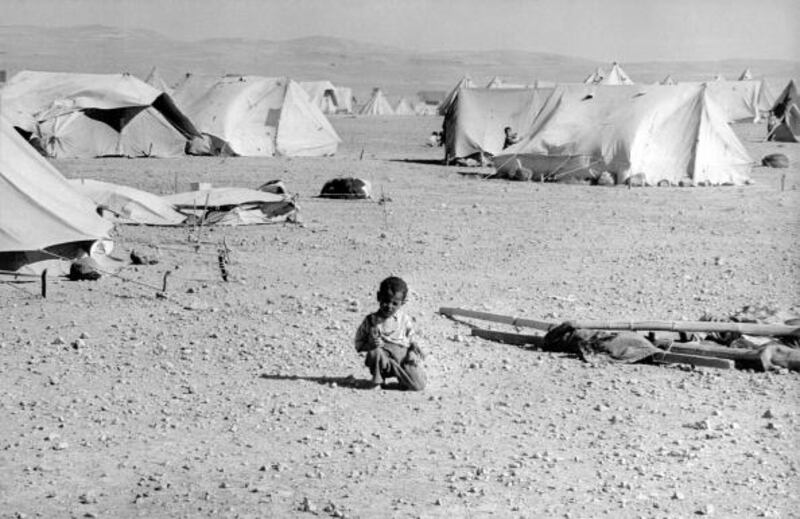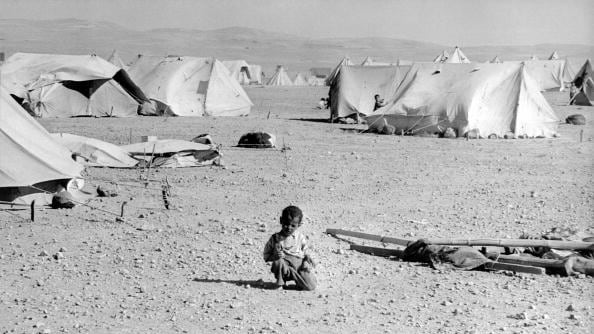A few days after the Israeli occupation of the Palestinian territories began on June 6, 1967, my father, Aziz Shehadeh, submitted a peace proposal to the Israeli government.

It contained eight points that covered every aspect of the conflict and proposed a sovereign Palestinian state alongside Israel. The full document is quoted in a new book by Avi Raz, The Bride and the Dowry, complete with the typing errors I then made. Reading this revealing book was both upsetting and enlightening and made me proud of my father for his foresight and courage.
The document had three parts:
A. Negotiations to be conducted between the inhabitants of the West Bank of Jordan and the Gaza Strip along the following lines:
1.The formation of an independent state to be admitted as a member state in the United Nations.
2. The territorial limits of the Palestine State shall be along the lines of the 1947 Partition Scheme with such necessary modifications as may be agreed upon by further negotiations and subject to the stipulations mentioned herein after.
3. The Old City of Jerusalem surrounded by the ancient walls shall be under the joint sovereignty of the state of Israel and Palestine and ruled in accordance with a special agreement to secure free access to all Holy Places.
4. The Capital of the Palestine state shall be the Arab section of Jerusalem.
5. The Palestine State shall be provided with a port on the Mediterranean Sea linked by a corridor as may be agreed upon by further negotiations.
6. Economic and non-aggression treaties shall be concluded between the two states.
7. The independence and territorial boundaries of the Palestine State shall be guaranteed by the United Nations.
8. Subject to any agreement as may be reached between the two States under the economic treaty referred to in paragraph 6 above all rights of the Palestinians in moveable and immovable properties existing at the termination of the mandate in both states shall be settled by mutual agreement. In case of dispute, however, such rights shall be settled in accordance with the principles laid down in the U.N. resolutions of Dec. 12, 1949 [sic, the correct date is: 11 December 1948].
B. The Israeli Government shall give written assurances that the above proposals are acceptable in principle and may be considered as a working scheme towards a final and peaceful solution of the Palestine problem in particular and the establishment of good relations with the Arab States in general.
C. When such assurances are given, attempts should be made to form a preliminary committee to call for a general assembly in order to adopt the necessary resolutions.
On the first day of the war, Levi Eshkol, then Prime Minister of Israel, told his generals that “even if we seize the Old City and the West Bank, we would eventually be forced to withdraw from them.” He was thinking of the previous occasion in 1956 when Israel occupied the Sinai and the Gaza Strip but was forced by the U.S. to withdraw. That bold action by the U.S. was never repeated. An Israeli Foreign Ministry official told American diplomats that as a result of the unexpected acquisition of the West Bank, “some people [in the cabinet] were losing their heads.” The more buoyant Dayan declared that Israel was now an empire. How right he was!
Rather than use the military victory to achieve peace with their neighbors, Israeli leaders were busy finding tactics that would help them win the diplomatic offensive and reject the various peace offers that came from Palestinians like my father and his supporters and other Arab leaders. According to Raz, King Hussein of Jordan “revealed on 12 July, 1967 to the American and British ambassadors in Amman separately that he was ready to make a bilateral settlement with Israel.” Raz then goes on to say that Israel did not take the Jordanian option seriously. “Playing for time, the Israelis simply used the contacts with the West Bankers to support their claim to the Americans that they were weighing their options. They used the contacts with King Hussein for the same purpose.”
I had always thought that the Arab states in the Khartoum Summit in September 1967 adopted the three no’s—no peace with Israel, no recognition of Israel, no negotiations with Israel—and that this destroyed any possibility of peace between Israel and the Arab states. Raz sheds a different light on the resolutions of this Summit. He writes that “when Nasser returned to Cairo from Khartoum, he told his information minister that ‘no peace with Israel’ meant ‘no peace treaty.’” A treaty, Nasser explained, would constitute recognition of the Arab defeat. “I cannot negotiate now,” he said, “but this doesn’t mean that I am not going to negotiate forever.” He also writes that “Israel, whose intelligence services managed to obtain the verbatim text of the in-camera deliberations at Khartoum, was fully aware of this sea change in the Arab attitude. Maj. Gen. Aharon Yariv, Israel’s chief of Military Intelligence, informed the Knesset Foreign Affairs and Security Committee that it had been decided at the summit to go for a ‘political solution.’”
The Israeli position towards the various peace initiatives was well expressed by the Israeli Foreign Minister, Abba Eban, when he said, “We should not give them [the Arabs] the honor of deciding what our policies toward them should be. We should have been looking at the non-Arab world, and not the Arab world itself.” Raz writes that Eban told the Labor party’s Expanded Political Committee on June 3, 1968 that the government was engaged not in a peace process but in a tactical political struggle designed to maintain the status quo and to avoid “all kinds of calamities” such as foreign political intervention.
These tactics and Israel’s cynical view of peace with its Arab neighbors have not changed. The same policy of viewing the negotiation process as an end in itself was pursued by Israel in its negotiations with the Palestinians over the past two decades. Likewise many of the other disingenuous offers Israel has been proposing to the Palestinians were already conceived in the early days of the occupation such as limited local autonomy and developing the towns near Jerusalem such as Bethany or Ramallah as the Palestinian capital instead of East Jerusalem.
Many of the practices that are still in some form current today were devised just a few months after the beginning of the occupation. They include the “open bridges” that allowed Palestinians to resume trade and travel between the two banks of the Jordan River, and the policy of indirect rule or “invisible administration” under which “an Arab can be born, live and die in the West Bank without ever seeing an Israeli official.” Both were the brainchild of Defense Minister Moshe Dayan.
There is little doubt that Israeli politicians proved to be brilliant diplomats and tacticians. Otherwise they could not have managed to rule over 6 million Palestinians and to convince the whole world that they have no option but to hold onto the Palestinian Occupied Territories. Yet as I reread the eight-point document my father prepared 45 years ago, I couldn’t but lament the loss of a unique opportunity for peace which, had Israeli leaders had the courage and sagacity to accept, would have saved my generation and those that came after from over four decades of occupation and hardship.
To this day, the U.S. refuses to play its hand and enforce international law, which requires that an occupier withdraw from territories it occupied in a belligerent war. Whether the Obama administration succeeds where previous ones failed will determine if Israel continues to be a warring empire or a country living in peace with its neighbors.
UPDATE: This story has been updated to reflect the following changes: the correct date of the U.N. resolutions referenced in part A8 of the elder Shehadeh's proposal; the correct spelling of Maj. Gen. Aharon Yariv's name; the correct date of Eban's speech to Labor's Expanded Political Committee; and the correct time elapsed since the elder Shehadeh's proposal.






